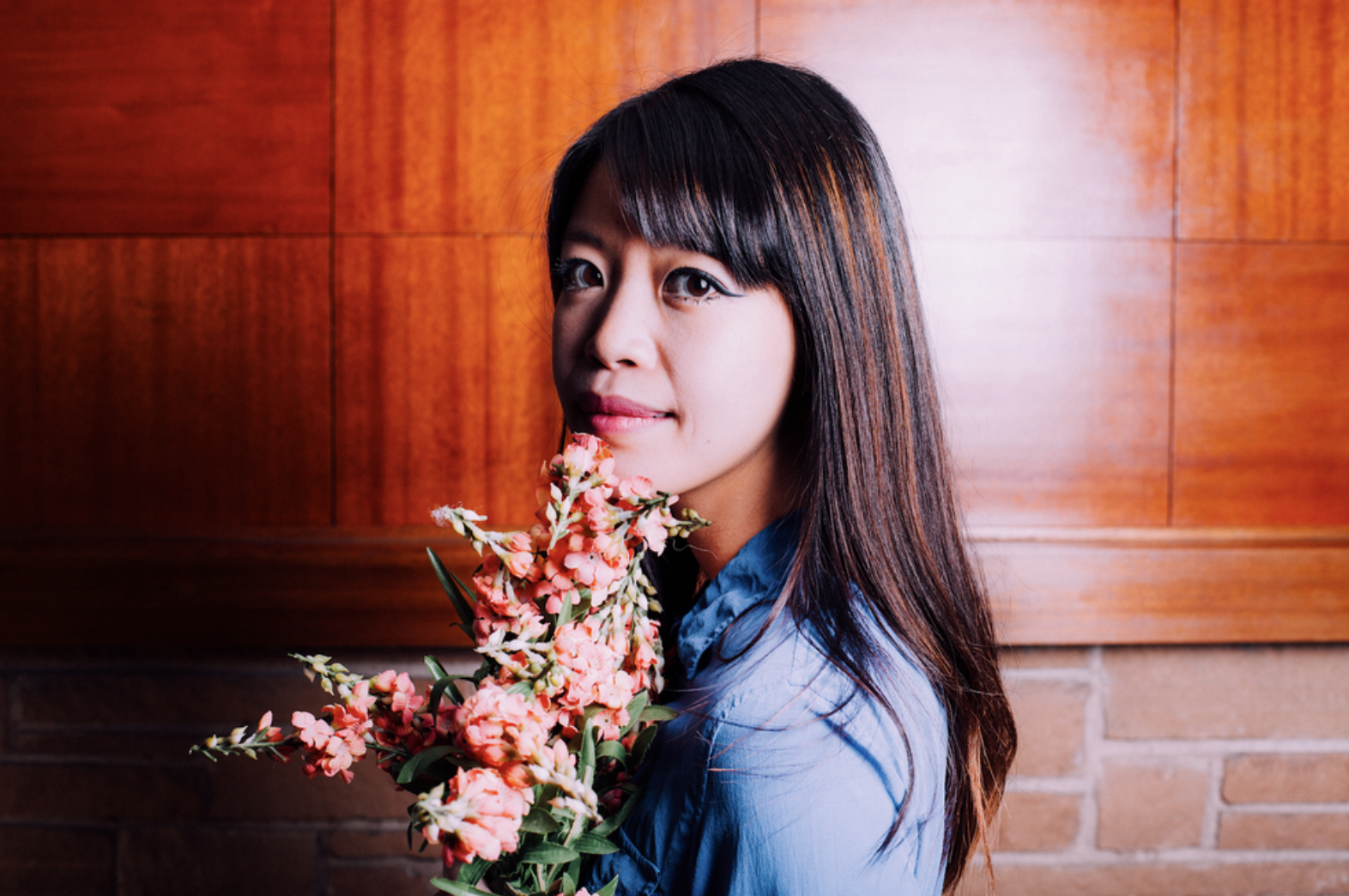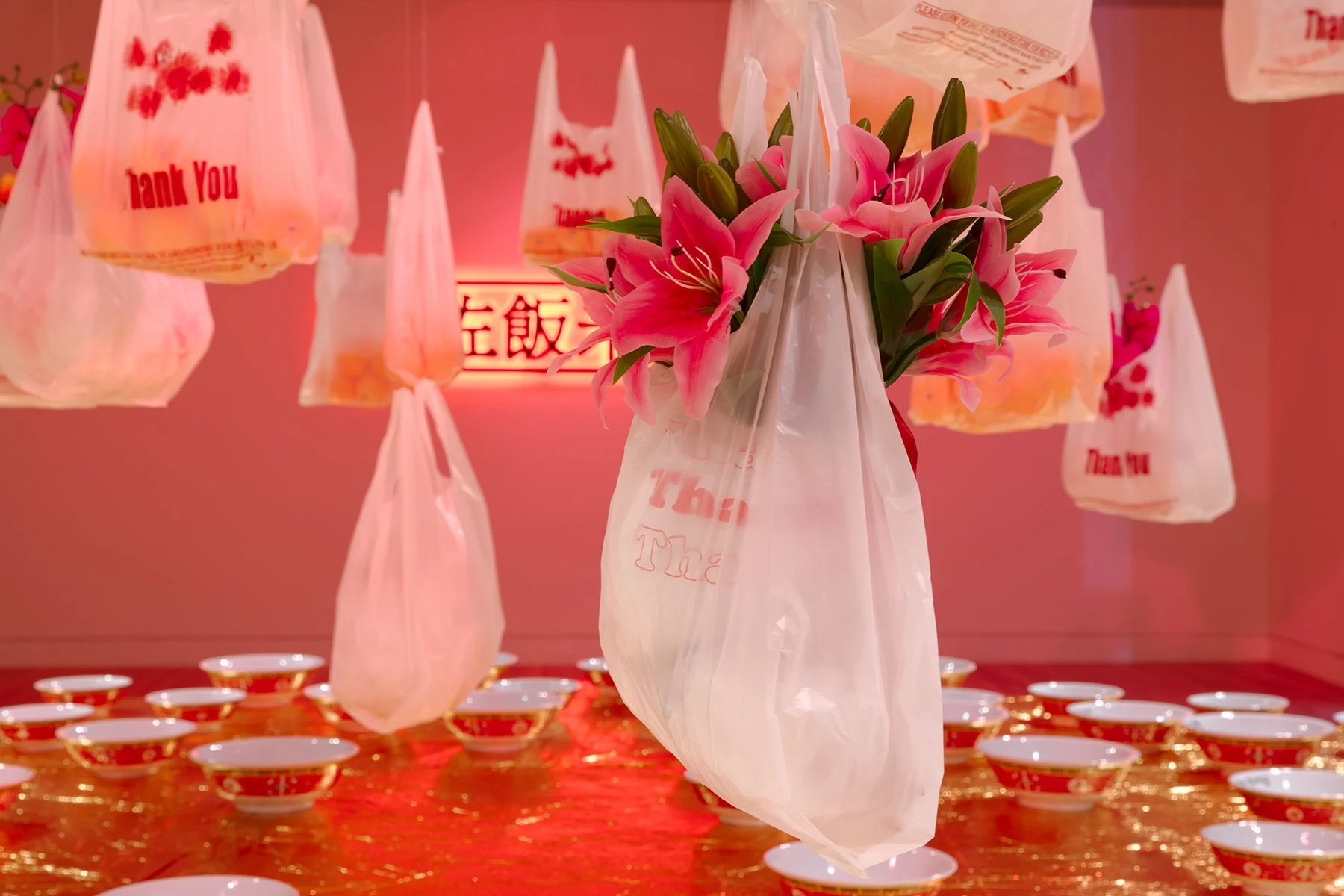Chinese-American writer Jane Wong feeds her ancestors through sculptural poetry
The Bellingham-based poet wrote After Preparing the Altar, The Ghosts Feast Feverishly upon learning about the Great Chinese Famine
Jane Wong, detail, installation of After Preparing the Altar, the Ghosts Feast Feverishly at Frye Art Museum (Seattle), 2019. Photo by Jueqian Fang
Richmond Art Gallery presents NOURISH from January 22 to April 3.
CHINESE-AMERICAN POET Jane Wong had never heard of the Great Leap Forward until she was in college, taking a course in Chinese politics. The 1958 to 1960 communist campaign to implement agricultural and industrial reforms led to the Great Chinese Famine, the largest famine in human history. Lasting until 1961, it claimed an estimated 36 million lives, including some of Wong’s family members.
Wong couldn’t return to that college class for a full two weeks, the revelation of the traumatic, silenced period in Chinese history and in her own story proving deeply unsettling. Years later came her response, in the best way she knows how: through poetry, with After Preparing the Altar, The Ghosts Feast Feverishly.
“That particular poem really grew out of thinking about my family, my ancestors, who unfortunately did not survive the Great Leap Forward,” Wong tells Stir by phone from Bellingham, where she teaches creative writing at Western Washington University. “In that particular piece, my ancestors address me directly and talk to me directly. I was really stunned, I think, when I wrote that poem; I didn’t expect them to be so voracious, so joyous. Even though it’s a dark topic, a fraught topic, it’s such an incredible experience listening to their voices a couple of generations down the line. It’s comforting.
“I was at a café in Bellingham grading papers…and suddenly it just felt like their voices came to me and I had to write it down,” she adds. “It was very spiritual when I wrote that poem in particular, because I was not expecting it.”
After Preparing the Altar, The Ghosts Feast Feverishly has evolved into a “sculptural poem”, an installation featuring an oversized round dining table that holds bowls inscribed with fragments of the piece. Viewers must walk around the table to read it, the poem in this form having no beginning and no end. Having premiered at Seattle’s Frye Art Museum in 2019 at Wong’s first solo art show, the installation comes to the Richmond Art Gallery as part of NOURISH, a new exhibition curated by Nan Capogna. Featuring other works by Wong as well as by locally based Taiwanese artist duo Mizzonk (Wan-Yi Lin and Roger Chen), the show explores topics such as isolation, food supply, the immigrant experience, nourishment, and mental health.
Jane Wong. Photo by Helene Christensen
After Preparing the Altar, The Ghosts Feast Feverishly has been adapted for the RAG exhibition and features updated elements, including a new “chandelier” made of soup spoons. Throughout her work, Wong draws inspiration from her childhood in New Jersey, specifically time spent in her parents’ Chinese-American restaurant in a Jersey Shore strip mall, far removed from the hunger and poverty of her family’s roots in rural China.
“My mom jokes that she gave birth to me and went straight to the restaurant,” says Wong, author of 2021’s How to Not Be Afraid of Everything and Overpour (2016). “I rarely spent time at our home.” The family served “Chinese American” food, dishes like beef and broccoli and sweet-and-sour chicken, many that they didn’t eat themselves and had to learn to make to appeal to North American diners’ sweeter palates. “My mom cooked food for customers but always made family meal—homestyle cooking,” Wong says. Maybe it was stir-fried tomato and egg or steamed chicken with cilantro, chive, and garlic sauce—simple Cantonese or Toisanese dishes.
“We would never serve that at the restaurant because they were too simple,” she says. “Within my culture, sometimes it’s hard to say I love you out loud; we cook for each other and share food together.”
Food is a way of bringing people together—even, in Wong’s view, if they’re no longer with us. She dreams of feeding her ancestors, a theme that appears in her work. “I can’t go back in time and literally give my ancestors the food I had today; I think about that all the time—if I’m eating a banana in the morning, I wish I could go back in time and give them this banana, but I can’t. But I can write poems. That is the one thing that I can do—share their story and try to be as respectful as I can in sharing that story, so for me it is kind of like feeding them as much they feed me as well. They nourish me in the afterlife.”
When Wong wasn’t at the family restaurant, she was at the public library—a place her parents could drop her off at. She remembers being surrounded by books and always reading; the librarians were her best friends. She knew early on she wanted to be a writer, not only because she loved the written word itself but because she felt compelled to share stories she wasn’t seeing elsewhere.
“One of the biggest things I realized at a very young age at that public library was that I didn’t really see a lot of characters or even writers themselves that reflected my upbringing. I didn’t relate. I knew from a young age I wanted to be a writer because I wanted to have a different story that was being told.”
She began with fiction but discovered poetry toward the end of college, enamoured by the form’s lyricism and freedom. “I was amazed by how I could express something in a way that was fragmented….It didn’t have to have a clear story,” she says. “It could be something that was felt more on an emotional or guttural level. I think for me, poetry is such a powerful tool or space in which I’m able to create a feeling or an experience.”
That ability to devise an experience is heightened with the kind of sculptural poetry seen in her installation. “Being in a gallery space was such an awakening,” she says. “I can change how readers or viewers move through a space or on the page by simply by changing the shape. I didn’t get to do that in fiction. This is very playful.”
Jane Wong, detail, installation of After Preparing the Altar, the Ghosts Feast Feverishly at Frye Art Museum (Seattle), 2019. Photo by Jueqian Fang
Wong has two other works on display at the exhibition, both new and based on poems from her 2021 book, including The Long Labors. It’s a video installation featuring the artist reciting the poem while making pork-and-chive dumplings out of rice paper printed with words and lines from the titular work that she stuffs, folds, and ultimately cooks. “I actually eat my poem,” she says.
Elsewhere in the exhibition, Mizzonk will present a new work titled Six Acres, named after the six-acre expanse in Metro Vancouver that the artistic pair now calls home—moving to the rural area after experiencing 9/11 from the rooftop of their Brooklyn studio. A projected animation produced from watercolour drawings on paper, the work grew out of their observations of living and working in the serene space. Both graduates of the Pratt Institute, they have shown work at the Oak Bay Outdoor Sculpture Exhibition and Outdoor Sculpture Exhibition in La Conner, Washington, among other places.
NOURISH will also feature a wide range of artists’ talks, workshops, hands-on activities, and more in partnership with #RichmondHasHeart, a city-run initiative that aims to build community by introducing the public to Richmond events.
For her Canadian premiere, Wong is fully aware that the subject matter of After Preparing the Altar, The Ghosts Feast Feverishly may be difficult for some in the local Chinese-Canadian community to absorb. “The Great Leap Forward is not a topic that is really spoken about in China, and a lot of the books about it are censored,” Wong says. “It’s definitely on my mind that this is a history that is going to be troubling for some….I want to honour everyone who goes to see the show that has that history, because I also worry that I might stir up past trauma. I want it to be as safe and generous as it can be.
“I’m really looking forward to seeing how people experience the show,” she adds. “I really hope when they enter the show, wherever they’re coming from in terms of their background, is to consider the histories and stories of your grandparents or great grandparents. What are those silences, that deep listening that everyone needs to do in terms of understanding where do you come from? Who are your ancestors? How do you reckon with them in that history in a way that feels nourishing and that’s thinking about the future, because the past is always connected to the future. I hope people reflect on their own families and histories even if it’s really difficult. I hope they find something nourishing in it and recognize that, especially with food, there’s already such history within recipes we pass down over and over, and it’s not just recipes, not just food but it’s a living document of your ghosts communicating with you. I think we forget about the dead all the time and I really hope that people who come to the show pay honour to those who came before….I hope it is that kind of spiritual experience.”















